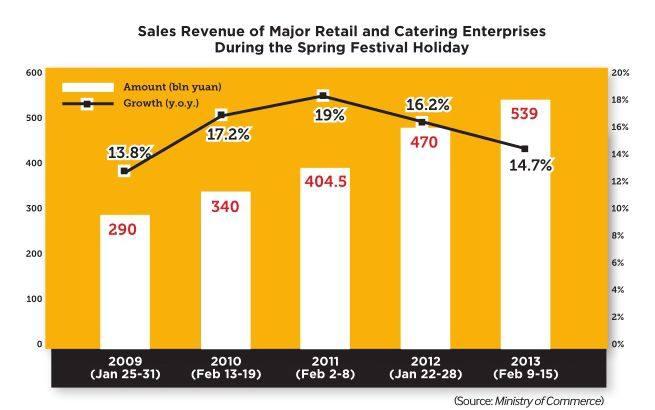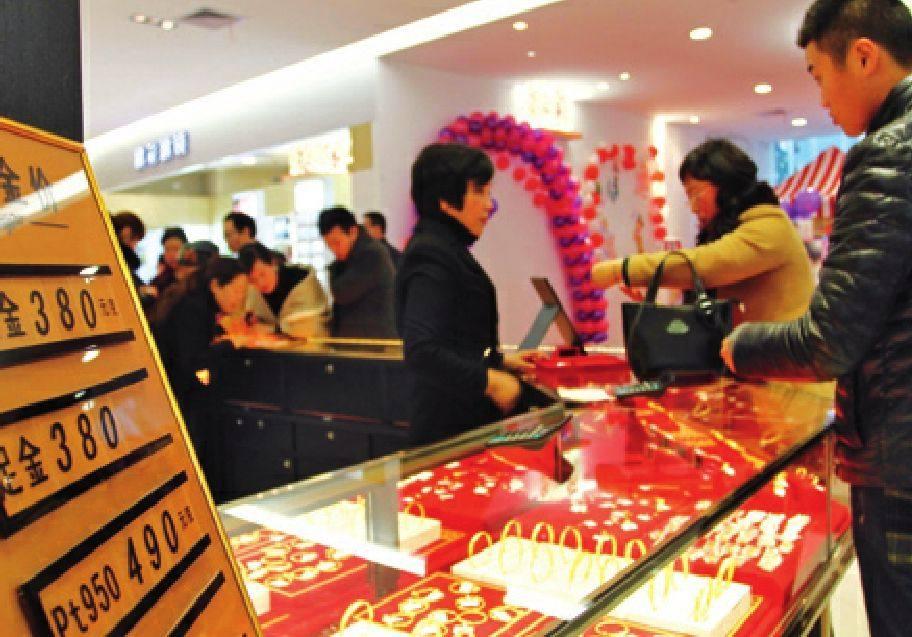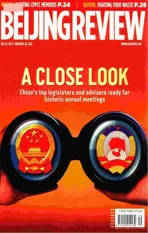Another Consumption Boom
2013-04-29Bydengyaqing
By deng yaqing
After holding their wedding ceremony in Zunyi, Guizhou Province, Tian Yun, a bond trader who works at a Shanghaibased securities company returned to Kaifeng, Henan Province, with her husband during the Spring Festival holiday (February 9-15). In her hometown, relatives and folks prepared a party to celebrate.
“My mother booked the banquet tables three months ahead. Since banquet booking is always popular during the Spring Festival, bookings for a larger gathering like a wedding reception are done as early as July,” said Tian.
In Kaifeng, a city along the Yellow River with a population of nearly 5 million, banquet prices increase by 20 percent during the Spring Festival. “A table at medium-priced restaurants would be priced at roughly 600 yuan ($96). We ordered 10 banquet tables. Counting other expenses, the party cost us about 10,000 yuan($1,603).”
The Chinese way of life is changing. Today, restaurants seem to be the most appropriate place for a family reunion while the older generation used to treat relatives and friends at home with traditional Chinese cuisine like braised pork.
From February 9 to 15, the sales revenue of major retail and catering enterprises in China rose 14.7 percent to 539 billion yuan ($86.4 billion) compared to the same period last year, according to the Ministry of Commerce(MOFCOM). Revenues of major catering businesses in Shanghai and Tianjin municipalities and Hubei and Henan provinces jumped 6 percent, 18.5 percent, 15.5 percent and 5.3 percent respectively during the holiday.
This consumption confidence is an indication that buoyant domestic demand is propping up the Chinese economy.
And the spending spree during the holiday was not confined to the domestic market. Against the backdrop of stagnating global consumption, Chinas Spring Festival has evolved into a bellwether for global economic growth.
Shopping binge
While daily necessities witnessed stable growth, goods traditionally consumed during the Spring Festival took the lions share of the consumer market.
Sales revenue for food and beverages by major retail enterprises shot up by 9.8 percent and 11.2 percent respectively, according to the MOFCOM.
Special purchases for the Spring Festival in Guangxi Zhuang Autonomous Region and Hunan Province both went up by 20 percent, according to statistics from local supermarkets.
Coupled with the Valentines Day, this Spring Festival has been a boon for jewelry retailers. With people busy tying the knot and buying jewelry to demonstrate love, sales revenue of gold, silver and jewelry by major retailers experienced a year-on-year increase of 38.1 percent, according to the MOFCOM. Gold, silver and jewelry stores in Beijing, like Caibai, Gongmei and Guohua, realized cumulative sales revenue of 630 million yuan ($101 million).
Big promotions for winter dresses and the unveiling of spring arrivals in shopping malls attracted throngs of holiday shoppers, with sales revenue rising by 6.3 percent and 7.5 percent respectively.
More and more people are longing for spending the holidays in a healthy and leisurely way. Besides traditional folk activities like temple fairs, fashionable ways to spend the holidays—like skiing, visiting hot springs and flower viewing—also grew in popularity.
In Beijing, Ditan Park Temple Fair alone received more than 1.02 million visitors during the festival, up 9.3 percent compared with the same period last year.
Visitors at ski resorts in Chongli, Hebei Province, registered 20,000 during the holiday. The spectacular sea of 300,000 tulip blossoms in Yuntai Park, Guangzhou, as well as Fengxiangs colorful clay sculptures and shadow puppetry, also captured numerous visitors.
With continuously improving living standards, electronic products and household electric appliances have become the new favorite presents given to relatives and friends. Sales of handsets, computers and cameras all show blowout growth.
Electronic products, such as SLR cameras and tablet computers, topped the list of most favored Spring Festival gifts, with sales revenue of high-end digital products jumping 36 percent year on year.
During the holiday, home appliance chain stores in Beijing, like Dazhong, Gome and Suning, saw cumulative sales revenue of 250 million yuan ($40 million).
Travel rush
In the past, people tended to stay at home for a family reunion. However, with Chinas remarkable social and economic progress, a stronger sense of recreation is beginning to surface. Furthermore, the exemption of highway tolls also help drive the expansion of the domestic tourism market.
During the holiday, 39 major tourism cities registered a total of 76 million visits, a 15-percent year-on-year increase, showed MOFCOM statistics.
Major tourist attractions remained crowded with tourists. Wuzhen in east Chinas Zhejiang Province took the lead among first-tier scenic areas, receiving 203,200 tourists, up 39.81 percent year on year. The number of tourists heading for Sanya in south Chinas Hainan Province soared by 12 percent to 247,000. Duty-free shops in Sanya were overwhelmingly popular. From February 10 to 15, sales revenue exceeded 130 million yuan ($20.84 million).
According to the 2013 Statistical Report on Tourism released by the National Holiday Tourism Office, a total of 203 million tourism trips were registered during the Spring Festival holiday, up 15.1 percent year on year, with total tourism revenue hitting 117.1 billion yuan ($18.78 billion). Per-capita consumption stood at 576.65 yuan ($92.4), up 0.09 percent year on year.
Statistics from the National Tourism Administration (NTA) showed that during the 2013 Spring Festival, travel agencies registered 4 million outbound travel trips, up 14 percent year on year, and 90 percent of those trips were to Asian destinations. Countries and regions such as Thailand, South Korea, Hong Kong, Macao and Taiwan were some of the more popular destinations for outbound travelers.
To brace for the shopping spree, overseas stores not only employed staff who can speak Chinese, but made other accommodations. In duty-free stores, labels were printed in simplified Chinese, and Chinese tourists were able to pay using their local debit cards and in renminbi, the Chinese currency.
“When I first arrived in Nepal, I found Chinese tourists everywhere, and many local people can speak a little Chinese,” said Zhang Jing, a 34 year-old Beijing resident, who signed up for a package tour to Nepal during the holiday and spent eight days in the capital Kathmandu, the world heritage site Chitwan National Park and the famous scenery site Pokhara. She paid 15,000 yuan ($2,405) for her package tour and spent 2,000 yuan ($321) more on shopping.
As the number of outbound travelers from Europe and the United States continues to decline, travelers from China made 80 million outbound trips in 2012, said the NTA. According to a report by The Washington Post, overseas consumption by Chinese people reached $85 billion in 2012, two times the annual revenue of Exxon Mobil, the U.S. oil giant with the highest revenue.
In some sense, its safe to say Chinas Spring Festival now has a global reach.
